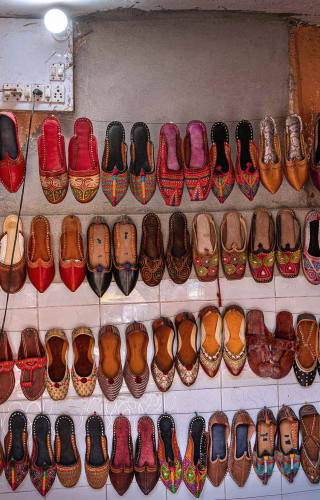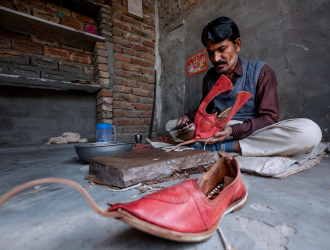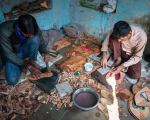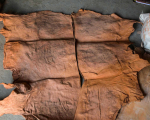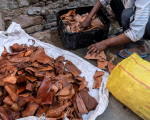Rajasthan is known for its leatherwork items which include bags, books, belts, mojaris (leather shoes) and musical instruments. In earlier times, making leather goods was the specialisation of the mochi (cobbler). Every village had a Mochi community which produced leather items. Specific to Rajasthan’s history and culture, mochis also made lagaam (reins for horses), sheaths for keeping swords, shields made from animal hide, saddle used for riding horses and camels, body armour, and charas (a contraption to lift water from the well).
In rural Rajasthan, the mojari was a daily necessity, worn by both men and women. Men wore them on journeys on foot, tending livestock and working in agricultural fields. Women wore them to walk long distances to collect drinking water. The design of the mojari evolved to be highly functional. In the hot climate of Rajasthan, the shoe had to be airy; to walk long distances on rocky soil, it had to be tough and flexible; taking them off at homes and temples had to be easy—keeping these factors in mind, the mojari was designed as slip-on shoes with the top, side and back of the foot almost bare. It was made from locally sourced tanned vegetable (using the bark of babul tree) leather. The thermal properties of leather, together with the thick sole, protected the feet from the sand, pebbles and thorns, and the hot terrain.
In neighbouring Punjab—both in India and Pakistan—mojari is known as jutti. In Multan, in Pakistan, the mojari is known as khussa. In these regions, mojari making was patronised by high society, and footwear became an important element in traditional North Indian weddings where it was worn with Indian dresses like dhoti-kurta, kurta-pyjama, salwar-kameez or sherwani. In the Mughal period, the simple mojari became highly ornamental, although, over the centuries, the craft has also been influenced by aesthetic and functional sensibilities peculiar to Rajasthan. For example, the upward curled toe-ends are said to mimic the twirled moustaches of Rajput men, and the bright red embroidery matches the red textile of Rajasthan.
In Rajasthan, mojari is made in places like Jodhpur, Jhunjhunu, Ajmer, Bikaner, Jaisalmer and Jaipur. In Jodhpur city, mojaris are made in Jingar Mohalla, Sivanchi Gate and Girdikort Bazaar, and in some villages— Patodi, in Barmer district, which I visited. Patodi village is located 112 kilometres from Jodhpur. Here, more than 100 families are engaged in this profession, and they belong to a specific community known as Jingar. The Jingar people got their name from the word jins, meaning ‘saddle’.
At Patodi, mojaris are entirely handmade, using only leather from camel, goat, cow and buffalo, unlike other regions where textiles and rubber are also used. Different types of leather have different usage. For example, the outer sole, which is the thickest part of the shoe and prone to most wear and tear, is made from buffalo leather, which is tough and thick. The upper part is made of suede leather which can be punched easily. The embroidery is made from a special kind of thread, which has the softness and lustre of silk but the strength of nylon and doesn’t wear out easily. The threads are procured from Surat, in Gujarat.
Mojari is made in two halves. The top half is densely embroidered. All embroidery work is done by female members of the household, while men do the leatherwork, including cutting, punching and stitching. Women in Patodi are known for their exquisite embroidery work. Before starting the needlework, they draw designs on the leather from their own imagination. The shoes are not left- or right-footed, but can be worn on either foot, therefore a pair must have identical designs. Sometimes the trader gives a specific design if that is popular in the market. Once the embroidery is complete, the sole and the upper part are stitched using specially made waxed cotton threads.
The leather used is brought from tanneries in Uttar Pradesh. The cost of leather depends on its availability, size, finish and any existing defect. After washing, the leather is dried and segregated based on size, quality and texture. A trained hand then draws shapes on the leather before cutting it into various shapes. Shoe sizes range from 5 to 12. The cost of making the shoes depend on the size, the type and quality of leather used and the cost of embroidery. The embroidery includes both cost of labour and materials used. The richer the embroidery, the more expensive the shoe. Apart from wholesale orders, fashion designers order custom-made shoes for special clients and they are often embroidered in gold or silver thread. Mojaris have high demand in the wedding trousseau industry.
Though mojaris are popular at weddings, these high-end shoes can only be worn occasionally, hence they have a very niche market. The aam aadmi (common man) prefers buying machine-made shoes that are much cheaper. In comparison, hand-embroidered mojaris take days to make. The industry is also heavily dependent on exports. Over the years, several innovations have been incorporated to cater to a wider market with varying preferences. For example, mojaris which are exported to European countries involve more sequin work and beads. They are also made left- or right-footed because that is the system followed in Western countries. Open-toed mojaris is another new variation. Mules, which are fully backless, are also made these days.
Mojaris produced in Jodhpur are in demand not only for the comfort of usage in the hot climate of Rajasthan but also for its exquisite design, fitting, finishing and embroidery work. Even then, the mojari industry in both Rajasthan and Punjab is facing stiff challenges. Machine-made shoes are the main cause for the decline in demand for hand-crafted shoes. Low availability and high cost of raw materials, slow making process, lack of skilled labour to replace old embroiderers, lack of interest in family members, low wages and low institutional support are other factors causing its decline. Some craftsmen accept they are not aware of the latest technology, neither can they afford modern machines to gain an advantage in the market.
To address these concerns, NGOs and Rajasthan state Tourism Department are jointly working to organise programmes on new designs, technology and marketing techniques to train the young generation and enthusiastic artisans. To revitalise the Jodhpur mojari, there is a need to provide appropriate input in technology, materials, design, economic and fashion aspects that will ensure profitability and marketability of the shoes. The decline in demand has resulted in lower income for the families still working in this sector. This situation has been further aggravated by the nationwide lockdown in 2020 due to the Covid-19 pandemic, which affected the tourism industry in Rajasthan. In this regard, government intervention in the form of financial support, tax relief and loan facilities is necessary. Families in Patodi village hope that timely intervention can secure the mojari-making craft a stable future, just like the old English idiom, ‘A stitch in time, saves nine.’
This content has been created as part of a project partnered with the Royal Rajasthan Foundation, the social impact arm of Rajasthan Royals, to document the cultural heritage of the state of Rajasthan.
